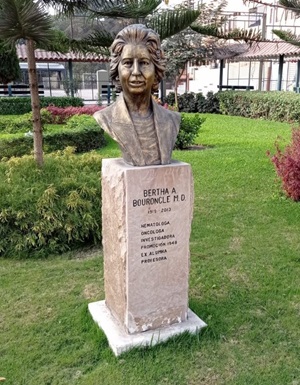Dr. Bertha Bouroncle: A Pioneer in Peruvian Hairy Cell Leukemia


 Dr. Bertha Bouroncle was born in 1919 in Trujillo, Peru. Her father, Luis, was a medical doctor and Harvard University alumnus. She was interested in medicine from an early age and attended San Fernando Medical School of the Universidad Nacional Mayor de San Marcos in Lima, Peru, where she was the only woman in her class. She pursued laboratory research as a medical student and developed a particular interest in hematology while working in the lab. She graduated in 1947 as class valedictorian.1
Dr. Bertha Bouroncle was born in 1919 in Trujillo, Peru. Her father, Luis, was a medical doctor and Harvard University alumnus. She was interested in medicine from an early age and attended San Fernando Medical School of the Universidad Nacional Mayor de San Marcos in Lima, Peru, where she was the only woman in her class. She pursued laboratory research as a medical student and developed a particular interest in hematology while working in the lab. She graduated in 1947 as class valedictorian.1
Dr. Bouroncle won a one-year graduate scholarship to study in the United States and chose to attend the Ohio State University (OSU) School of Medicine. Her goal was to work with two renowned hematologists at OSU, Drs. Charles Doan and Bruce Wiseman. After finishing her one-year fellowship, she was accepted to the OSU Internal Medicine residency program, served as OSU’s first female chief resident, and then completed training in hematology. Immediately after completing her training in 1954, she was inducted into the school of medicine as an assistant professor. Just three years later, she was promoted to associate professor.2
Dr. Bouroncle’s most significant accomplishment was her discovery of hairy cell leukemia (HCL) in 1958. HCL is a rare, indolent B-cell lymphoproliferative disorder characterized by infiltration of bone marrow and spleen by neoplastic cells with cytoplasmic hair-like projections.3 Dr. Bouroncle was the first to report this condition and wrote a manuscript in which she detailed 26 cases, identifying the condition as an independent hematologic and pathologic entity.4 In 1970, she was promoted to senior professor, becoming the first woman in the state of Ohio to achieve a full professorship.5
During the 1980s, in collaboration with Drs. Michael Grever and Eric Kraut, Dr. Bouroncle developed a treatment for HCL known as deoxycoformycin (also called pentostatin). This treatment is still an option for the treatment of HCL today.3 Dr. Bouroncle is considered a pioneer of OSU’s focus on cancer and leukemia treatment, and her discoveries in hematology and oncology ultimately started an ongoing legacy at the university in cancer research and treatment. She was also instrumental in the foundation of The James Cancer Hospital at OSU.6
 |
| Photo. Sculpture of Dr. Bertha Bouroncle at San Fernando Medical School Universidad Nacional Mayor de San Marcos. The sculpture reads, “Bertha A. Bouroncle, MD, 1919-2013. Hematologist-oncologist researcher, class 1948, alumni, teacher.” |
As a woman in medicine, Dr. Bertha Bouroncle was ahead of her time and inspired great respect for her research and clinical care accomplishments. She was noted to have had an excellent bedside manner and made sure to learn very specific details about her patients.1 She has been described as a “lioness”7 and the “hairy cell leukemia godmother.”5 She was also an excellent educator and won several teaching-related awards at OSU.6 The university describes her accomplishments stating, “Many people believe that this achievement [discovery of hairy cell leukemia and its treatment] is one of the most important scientific discoveries in the history of the University.”8
In 1989, she retired and was given the title of professor emerita. She continued to give back to the community by treating patients and creating the post of Bertha Bouroncle and Andrew Pereny Chair of Medicine to raise funds for cancer research at OSU. In 2001, OSU established the Bertha Bouroncle Distinguished Lecture Award in her honor.6 Dr. Bouroncle also honored her roots by donating $200,000 to build a new research laboratory at San Fernando Medical School; the school named the laboratory in her honor.9 Dr. Bouroncle passed away in August of 2013, but her legacy will endure as both a prodigious scientist and an inspiration to young women interested in pursuing the field of scientific research.
They say that no one is a prophet in their own land. As a student at San Fernando Medical School in Peru, I noticed that there is only one small statue of Dr. Bouroncle on campus (Photo) and no mention of her great achievements in our history of medicine course. In 2021, the Peruvian government published Female Scientists From Peru: 24 Stories to Discover,10 but Dr. Bouroncle’s name was not included. Nevertheless, she made a significant impact on my desire to pursue a career in hematology and has served as an inspiration for me and many other Peruvian women in medicine. Her legacy lives on in many of us, and we write this piece in her honor.
- Rozas Olivera VV. Semblanza de la Dra. Bertha Bouroncle. An Fac Med. 2014;75(4):375-377.
- Bertha Bouroncle: Biography. Ohio State University. Last accessed 2021. Access via https://u.osu.edu/biorootsgroup8/biography/.
- Ravandi F. Hairy cell leukemia. Clin Lymphoma Myeloma. 2009;9 Suppl 3:S254-S259.
- Bouroncle BA, Wiseman BK, Doan CA. Leukemic reticuloendotheliosis. Blood. 1958;13(7):609-630.
- Ward D. Hairy cell godmother. Frontiers. 2009.
- Ohio State saddened bypassing of Dr. Bertha Bouroncle. The James; Ohio State University Comprehensive Cancer Center. Last accessed 2021. Access via http://cancer.convio.net/site/PageServer?pagename=cc_sept_2013_bouroncle.
- Bertha Bouroncle: A lioness’ share of contributions. The James; Ohio State University Comprehensive Cancer Center. Last accessed 2021. Access via https://cancer.osu.edu/about/publications-and-reports/magazines-and-publications/impactcancer/2013/winter/bertha-bouroncle.
- Bertha A. Bouroncle, M.D. Upper Arlington Historical Society. Last accessed 2021. Access via https://www.uahistory.org/woh-bouroncle.
- Crean laboratorio en San Marcos en honor de destacada peruana. El Comercio. 2015. Last accessed 2021. Access via https://elcomercio.pe/ciencias/historia/crean-laboratorio-san-marcos-honor-destacada-peruana-noticia-1782252/.
- Vásquez Y. Científicas del Perú: 24 historias por descubrir. 2021. Access via http://hdl.handle.net/20.500.12390/2259.